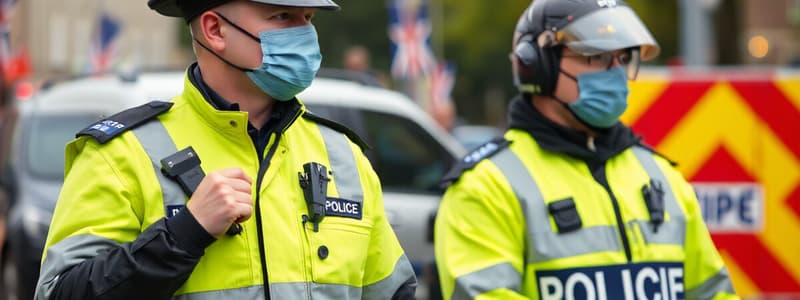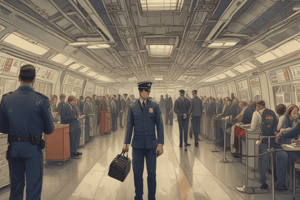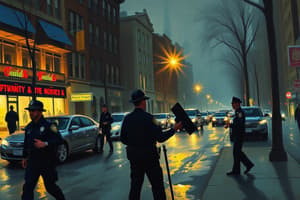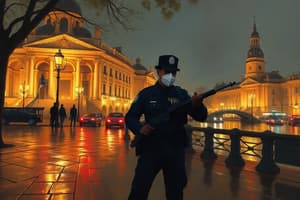Podcast
Questions and Answers
Based on the data, which statement is most accurate regarding injuries sustained during foot pursuits?
Based on the data, which statement is most accurate regarding injuries sustained during foot pursuits?
- Suspects are more likely to sustain injuries of any kind compared to deputies. (correct)
- Minor injuries are more common for suspects, while serious injuries are more common for deputies.
- Deputies are more likely to sustain serious injuries like fractures than suspects.
- Deputy injuries are often unreported, thus skewing the statistics.
What is the primary reason for emphasizing the importance of remembering the statistic that 42% of deputies involved in a pursuit were assaulted?
What is the primary reason for emphasizing the importance of remembering the statistic that 42% of deputies involved in a pursuit were assaulted?
- To highlight the need for improved physical fitness standards for law enforcement.
- To justify the use of lethal force in situations where deputies feel threatened.
- To encourage deputies to use maximum force when engaging in foot pursuits.
- To stress the high risk of assault during pursuits and reinforce the importance of training and safety. (correct)
Which of the following tactics is LEAST likely to improve an officer's safety during a foot pursuit?
Which of the following tactics is LEAST likely to improve an officer's safety during a foot pursuit?
- Establishing a perimeter and waiting for backup if visual contact is lost.
- Maintaining constant radio communication and providing detailed suspect descriptions.
- Slowing down and maintaining surveillance from a safe distance.
- Immediately engaging the suspect at close range to prevent escape. (correct)
What is the recommended course of action if an officer loses sight of a fleeing suspect during a foot pursuit?
What is the recommended course of action if an officer loses sight of a fleeing suspect during a foot pursuit?
What is the significance of the statement, 'Remember that it is usually not a matter of if you will catch the suspect; just when you will catch them,' in the context of foot pursuits?
What is the significance of the statement, 'Remember that it is usually not a matter of if you will catch the suspect; just when you will catch them,' in the context of foot pursuits?
Which of the following best describes the primary goal of preventative patrol?
Which of the following best describes the primary goal of preventative patrol?
According to the crime triangle theory, what three elements must be present for a crime to likely occur?
According to the crime triangle theory, what three elements must be present for a crime to likely occur?
Directed Enforcement, also known as "hot spot policing", is based on what principle?
Directed Enforcement, also known as "hot spot policing", is based on what principle?
In the context of Directed Enforcement, what is the purpose of creating specialized task forces?
In the context of Directed Enforcement, what is the purpose of creating specialized task forces?
Within the Contact and Cover principle, which officer is designated as the 'contact officer'?
Within the Contact and Cover principle, which officer is designated as the 'contact officer'?
How does Directed Enforcement differ from Preventative Patrol in addressing crime?
How does Directed Enforcement differ from Preventative Patrol in addressing crime?
Which strategy is most likely to be effective at addressing a sudden increase in vehicle thefts in a specific neighborhood?
Which strategy is most likely to be effective at addressing a sudden increase in vehicle thefts in a specific neighborhood?
Which of the following scenarios exemplifies the concept of 'lack of capable guardianship' in the crime triangle?
Which of the following scenarios exemplifies the concept of 'lack of capable guardianship' in the crime triangle?
Which of the following is the primary difference between an 'Attempt to Locate' (ATL) and a 'Be on the Lookout' (BOLO) broadcast?
Which of the following is the primary difference between an 'Attempt to Locate' (ATL) and a 'Be on the Lookout' (BOLO) broadcast?
When conducting a security check at a building with a history of false alarms, what is the most important action an officer should take?
When conducting a security check at a building with a history of false alarms, what is the most important action an officer should take?
Which of the following pieces of information is least critical to include when providing a description for an ATL or BOLO?
Which of the following pieces of information is least critical to include when providing a description for an ATL or BOLO?
What is the best course of action for a patrol officer who recognizes a fellow officer working undercover in plain clothes?
What is the best course of action for a patrol officer who recognizes a fellow officer working undercover in plain clothes?
According to the information, what percentage of foot pursuits resulted in suspects assaulting deputies?
According to the information, what percentage of foot pursuits resulted in suspects assaulting deputies?
Why is it important for officers to gather information from the security company during a security check?
Why is it important for officers to gather information from the security company during a security check?
During a foot pursuit, which factor would LEAST likely influence an officer's decision to continue the pursuit?
During a foot pursuit, which factor would LEAST likely influence an officer's decision to continue the pursuit?
Which of the following tactics is NOT emphasized when approaching a building for a security check?
Which of the following tactics is NOT emphasized when approaching a building for a security check?
What should an officer prioritize first when they are determining whether to engage in a foot pursuit?
What should an officer prioritize first when they are determining whether to engage in a foot pursuit?
Which action is typically the responsibility of the contact officer in a contact and cover scenario?
Which action is typically the responsibility of the contact officer in a contact and cover scenario?
What is the primary purpose of the cover officer?
What is the primary purpose of the cover officer?
When encountering an officer working in plain clothes, what information is most crucial for a patrol officer to know beforehand?
When encountering an officer working in plain clothes, what information is most crucial for a patrol officer to know beforehand?
During a foot pursuit, research indicated that deputies used soft-hand tactics in what percentage of pursuits?
During a foot pursuit, research indicated that deputies used soft-hand tactics in what percentage of pursuits?
Why is maintaining an adequate reactionary gap important in contact and cover scenarios?
Why is maintaining an adequate reactionary gap important in contact and cover scenarios?
What is the recommended stance that gives officers the most stability and tactical advantage?
What is the recommended stance that gives officers the most stability and tactical advantage?
What is the purpose of a crime broadcast?
What is the purpose of a crime broadcast?
In the context of contact and cover, what does 'positioning' primarily refer to?
In the context of contact and cover, what does 'positioning' primarily refer to?
According to the International Association of Chiefs of Police research, what percentage of foot pursuits resulted in the use of impact weapons by deputies?
According to the International Association of Chiefs of Police research, what percentage of foot pursuits resulted in the use of impact weapons by deputies?
What should be the first step an officer takes upon being dispatched to a building alarm?
What should be the first step an officer takes upon being dispatched to a building alarm?
What is a key advantage of using triangulation in officer positioning during suspect contact?
What is a key advantage of using triangulation in officer positioning during suspect contact?
Why is effective communication between the contact and cover officers crucial when using triangulation?
Why is effective communication between the contact and cover officers crucial when using triangulation?
During a foot pursuit, which of the following suspect characteristics would most significantly elevate the risk to the pursuing officer?
During a foot pursuit, which of the following suspect characteristics would most significantly elevate the risk to the pursuing officer?
In a triangulation strategy with two officers and one suspect, what tactical advantage are the officers trying to achieve?
In a triangulation strategy with two officers and one suspect, what tactical advantage are the officers trying to achieve?
When a single officer faces multiple suspects, what tactic can they use to maintain a tactical advantage?
When a single officer faces multiple suspects, what tactic can they use to maintain a tactical advantage?
Before beginning a shift, what is a critical aspect of preparation that an officer should undertake?
Before beginning a shift, what is a critical aspect of preparation that an officer should undertake?
Why is it important for officers to check their handcuffs before starting a shift?
Why is it important for officers to check their handcuffs before starting a shift?
What is the main problem with “contact and cover” or “L-shape” tactic?
What is the main problem with “contact and cover” or “L-shape” tactic?
What is the analogy used to describe the advantage of triangulation?
What is the analogy used to describe the advantage of triangulation?
When using triangulation tactics, which statement is most accurate?
When using triangulation tactics, which statement is most accurate?
Which of the following is a true statement regarding distance?
Which of the following is a true statement regarding distance?
An officer notices their holster's snap is not functioning correctly. What immediate action should the officer take?
An officer notices their holster's snap is not functioning correctly. What immediate action should the officer take?
During a shift briefing, officers are informed of a recent increase in vehicle break-ins in a specific neighborhood. What is the MOST appropriate course of action for the officers during their patrol?
During a shift briefing, officers are informed of a recent increase in vehicle break-ins in a specific neighborhood. What is the MOST appropriate course of action for the officers during their patrol?
Before beginning a shift, an officer is dealing with a significant personal issue. What is the MOST effective strategy for managing this situation while on duty?
Before beginning a shift, an officer is dealing with a significant personal issue. What is the MOST effective strategy for managing this situation while on duty?
An officer is dispatched to a call described as a 'domestic disturbance with possible weapons'. What should be the officer's PRIMARY consideration when driving to the scene?
An officer is dispatched to a call described as a 'domestic disturbance with possible weapons'. What should be the officer's PRIMARY consideration when driving to the scene?
When responding to a call, under what circumstances is it MOST appropriate for an officer to park their patrol vehicle 'out of sight' upon arrival?
When responding to a call, under what circumstances is it MOST appropriate for an officer to park their patrol vehicle 'out of sight' upon arrival?
An officer is approaching a building where a burglary is in progress. What factor is LEAST important when determining their approach?
An officer is approaching a building where a burglary is in progress. What factor is LEAST important when determining their approach?
During a high-risk traffic stop, an officer is giving verbal commands to the suspect. What is the PRIMARY reason for turning down the radio mic during this interaction?
During a high-risk traffic stop, an officer is giving verbal commands to the suspect. What is the PRIMARY reason for turning down the radio mic during this interaction?
Which factor is the MOST critical in determining the appropriate speed when an officer is driving to the scene of a call?
Which factor is the MOST critical in determining the appropriate speed when an officer is driving to the scene of a call?
According to the content, what is the PRIMARY purpose of shift briefings?
According to the content, what is the PRIMARY purpose of shift briefings?
What is the MOST important reason for officers to ensure their uniform is neat and pressed?
What is the MOST important reason for officers to ensure their uniform is neat and pressed?
Why is playing the 'what-if' game considered a valuable mental preparation technique for law enforcement officers?
Why is playing the 'what-if' game considered a valuable mental preparation technique for law enforcement officers?
Prior to beginning patrol, an officer ensures their rifle cycles properly on an empty chamber and is secured in the vehicle. What is the PRIMARY reason for this?
Prior to beginning patrol, an officer ensures their rifle cycles properly on an empty chamber and is secured in the vehicle. What is the PRIMARY reason for this?
An officer finds contraband in the back seat of their patrol vehicle at the beginning of their shift. What IMMEDIATE action should the officer take?
An officer finds contraband in the back seat of their patrol vehicle at the beginning of their shift. What IMMEDIATE action should the officer take?
Before starting a shift, what is the PRIMARY reason for an officer to check the medical equipment in their patrol vehicle?
Before starting a shift, what is the PRIMARY reason for an officer to check the medical equipment in their patrol vehicle?
What is the MOST important reason for an officer to check the weapon release system in their patrol vehicle?
What is the MOST important reason for an officer to check the weapon release system in their patrol vehicle?
Flashcards
Preventative Patrol
Preventative Patrol
Policing that aims to remove opportunities for crime by increasing police presence.
Goals of Preventative Patrol
Goals of Preventative Patrol
Deterrence of crime, apprehending criminals and satisfying public demands.
Crime Triangle
Crime Triangle
A theory stating crime needs a motivated offender, suitable victim, and lack of guardianship.
Directed Enforcement
Directed Enforcement
Signup and view all the flashcards
Hot Spot Policing
Hot Spot Policing
Signup and view all the flashcards
Directed Enforcement Task Forces
Directed Enforcement Task Forces
Signup and view all the flashcards
Contact and Cover
Contact and Cover
Signup and view all the flashcards
Contact Officer
Contact Officer
Signup and view all the flashcards
Foot Pursuit Injury Rates
Foot Pursuit Injury Rates
Signup and view all the flashcards
First Step in a Foot Pursuit
First Step in a Foot Pursuit
Signup and view all the flashcards
Safe Foot Pursuit Tactics
Safe Foot Pursuit Tactics
Signup and view all the flashcards
Importance of Cognitive Control
Importance of Cognitive Control
Signup and view all the flashcards
Utilizing Resources in Pursuit
Utilizing Resources in Pursuit
Signup and view all the flashcards
Pre-Shift Equipment Check
Pre-Shift Equipment Check
Signup and view all the flashcards
Shift Briefings
Shift Briefings
Signup and view all the flashcards
Mental Preparation
Mental Preparation
Signup and view all the flashcards
The 'What-If' Game
The 'What-If' Game
Signup and view all the flashcards
Driving to the Scene
Driving to the Scene
Signup and view all the flashcards
Patrol Vehicle Positioning
Patrol Vehicle Positioning
Signup and view all the flashcards
Approach to the Scene
Approach to the Scene
Signup and view all the flashcards
Principles of Approaching
Principles of Approaching
Signup and view all the flashcards
Radio Traffic
Radio Traffic
Signup and view all the flashcards
Flashlight Readiness
Flashlight Readiness
Signup and view all the flashcards
Radio Functionality
Radio Functionality
Signup and view all the flashcards
Baton Check
Baton Check
Signup and view all the flashcards
Magazine Loading
Magazine Loading
Signup and view all the flashcards
Glove Availability
Glove Availability
Signup and view all the flashcards
Holster and Weapon
Holster and Weapon
Signup and view all the flashcards
Contact Officer Duties
Contact Officer Duties
Signup and view all the flashcards
Cover Officer Responsibilities
Cover Officer Responsibilities
Signup and view all the flashcards
Maximizing Contact and Cover
Maximizing Contact and Cover
Signup and view all the flashcards
Reactionary Gap
Reactionary Gap
Signup and view all the flashcards
Bladed Stance
Bladed Stance
Signup and view all the flashcards
Triangulation (Officer Positioning)
Triangulation (Officer Positioning)
Signup and view all the flashcards
Triangulation Angle
Triangulation Angle
Signup and view all the flashcards
Triangulation Advantage
Triangulation Advantage
Signup and view all the flashcards
Triangulation Analogy
Triangulation Analogy
Signup and view all the flashcards
Triangulation Adaptation
Triangulation Adaptation
Signup and view all the flashcards
Reverse Triangulation
Reverse Triangulation
Signup and view all the flashcards
Gear Check
Gear Check
Signup and view all the flashcards
Handcuff Placement
Handcuff Placement
Signup and view all the flashcards
Attempt to Locate (ATL)
Attempt to Locate (ATL)
Signup and view all the flashcards
Be On the Lookout (BOLO)
Be On the Lookout (BOLO)
Signup and view all the flashcards
ATL/BOLO Details
ATL/BOLO Details
Signup and view all the flashcards
Security Systems
Security Systems
Signup and view all the flashcards
Security Check Information Gathering
Security Check Information Gathering
Signup and view all the flashcards
Security Check Approach Tactics
Security Check Approach Tactics
Signup and view all the flashcards
Shift Briefing Info
Shift Briefing Info
Signup and view all the flashcards
Encountering Undercover Officer
Encountering Undercover Officer
Signup and view all the flashcards
Foot Pursuit Considerations
Foot Pursuit Considerations
Signup and view all the flashcards
Factors in Deciding to Pursue
Factors in Deciding to Pursue
Signup and view all the flashcards
Nature of Foot Pursuits
Nature of Foot Pursuits
Signup and view all the flashcards
Use of Force in Pursuits
Use of Force in Pursuits
Signup and view all the flashcards
Soft-hand tactics
Soft-hand tactics
Signup and view all the flashcards
Hard-hand tactics
Hard-hand tactics
Signup and view all the flashcards
Building Search Tactics
Building Search Tactics
Signup and view all the flashcards
Study Notes
Patrol Strategies
- Preventative patrol aims to eliminate opportunities for misconduct by increasing police presence.
- Goals include crime deterrence, apprehension, public satisfaction, security, and recovering stolen property.
- The theory involves a crime triangle: motivated offender, suitable victim, and lack of guardianship. Removing any element reduces crime likelihood.
- Directed Enforcement, or "hot spot policing," assigns specialized groups to target specific issues.
- It uses data to identify high-crime areas and increases police presence and enforcement there.
- Task forces are created to address specific problems traditional policing hasn't resolved.
Contact and Cover
- Contact and Cover assigns roles to officers interacting with a suspect.
- The contact officer leads conversations, conducts searches, records information, recovers evidence, and handcuffs arrestees.
- The cover officer observes the incident, protects the contact officer, corroborates events, discourages escapes, alerts to hidden evidence, monitors the radio, intervenes with force if needed and warns of threats.
- Maximizing effectiveness involves distance, stance, and positioning.
- Distance maintains a reactionary gap, allowing time to react.
- Distance shouldn't hinder communication or allow striking, but should allow item exchange between the offender and the police.
- Stance should provide stability and a tactical advantage. The bladed stance or field interview stance is recommended.
- Positioning involves triangulation, where officers position themselves to form a triangle.
- Triangulation minimizes crossfire potential and forces the suspect to fight on two fronts.
- Officers communicate and adjust to maintain triangulation, with either officer able to take the lead.
- With one officer and multiple suspects, the officer should position themselves to prevent the suspects from triangulating.
Preparation
- Checking personal gear is essential before a shift.
- Duty belt equipment includes handcuffs, flashlight, radio, baton, magazines, gloves, holster, and duty weapon.
- Rifles/shotguns should be checked for proper cycling and secured in the vehicle.
- Uniforms should be neat and pressed for a professional appearance.
- Patrol vehicles need to be checked, including:
- Lights
- Sirens
- Radios
- Medical equipment
- Fire extinguishers
- Weapon release system
- Back seat to be empty is a must
- Briefings provide opportunities for information gathering and sharing.
- Mental preparation is crucial, leaving personal issues at the station and focusing on work.
- The "what-if" game can help develop mental preparedness for various scenarios.
Patrolling Safely and Effectively
- Police response can be categorized into:
- Driving to the scene
- Arrival on scene
- Approach
- Driving safely to the scene is vital, adjusting speed based on the call's urgency.
- Vehicle positioning can provide a tactical advantage; parking out of sight is a common rule.
- Approach to the scene depends on the situation, whether it’s direct, indirect, slow, methodical, or fast.
- Principles that remain true no matter the incident:
- Avoid slamming doors
- Turn off sirens
- Lower the radio mic
- Avoid silhouetting
- Turn off lights (debatable)
Radio Traffic
- Radio transmissions vary by agency policies and procedures.
- Knowledge of protocols is crucial for:
- Contacting dispatch
- Calling out traffic stops
- Running subjects for wants and warrants
- Calling out arrests and transportation
- Status Checks
- Officer down situations
- Phonetic Alphabet
Crime Broadcasts
- Crime broadcasts include "Attempt toLocate (ATL)" and "Be on the Lookout (BOLO)."
- ATL is a request to dispatch to broadcast a situation, usually involving a person or vehicle, and instructs law enforcement to search for the suspect/vehicle
- BOLO is for dispatch to broadcast information, notifying law enforcement to keep an eye out for a suspect.
Security Checks
- Security checks at alarmed buildings require vigilance due to potential complacency.
- When conducting security checks, you should:
- Gather information from the security company and owner
- Assess the need for additional officers
- Limit noise on arrival.
- Use cover and concealment.
- Ensuring communication with partner.
- Advise dispatch of entrance.
- Employ building search tactics.
Plain Clothes and Undercover
- Be aware of undercover operations and plain clothes officers in the department.
- Avoid directly approaching and interacting with them to maintain their cover.
Foot Pursuits
- Foot pursuits are emotionally charged and dangerous.
- Factors to consider when determining to initiate a pursuit:
- Suspect's potential warrants
- Armed status
- Fighting skills
- Physical fitness
- Mental state
- Drug influence
- Potential ambush locations
- Possible accomplices
- Tactics to improve safety:
- Immediately call for assistance and provide a description of the suspect and direction of travel
- Utilize surveillance from a safe distance
- Secure your position and set up a perimeter if sight is lost
- Regain focus, control breathing, and devise or review your plan before engaging
- Allow the suspect to tire out
- Request a K-9 unit or helicopter, if available.
Studying That Suits You
Use AI to generate personalized quizzes and flashcards to suit your learning preferences.




